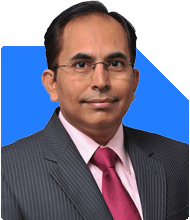Can I retire at 50? I have 2 lacs monthly income, 2.75 Cr in real estate and 1.35 Cr in investments.
Ramalingam Kalirajan |10876 Answers |Ask -Follow
Mutual Funds, Financial Planning Expert - Answered on Nov 11, 2024
He has an MBA in finance from the University of Madras and is a certified financial planner.
He is the director and chief financial planner at Holistic Investment, a Chennai-based firm that offers financial planning and wealth management advice.... more

Hi, I am 50 years old. Is my financial position sufficient enough to retire immediately? Myself and my wife's combined salary is 2 lacs (tax free) per month. We have a 24 year old daughter pursuing masters in Canada and she does not require any funds for completing her studies or living expenses as it is fully funded by the university. As for her marriage in future, we want to keep it simple and no plan to waste money like typical traditional ways. As regards to financial position, I am debt free, FD 27 lacs, Bonds 80 lacs. Both investments gives me avg. 85000 interest (taxable) per month. Apart from this, I have emergency bank balance 9 lacs, equity investment 8 lacs, PF 22 lacs. My real estate investments are 2.75 Cr. of which 1.75 Cr. worth property is ready for sale and intend to invest the proceeds in Bonds for passive income. Remaining 1 Cr. worth property we will keep it for living. As for insurance, there is a term insurance of 1.2 Cr. and family Health insurance 25 lacs that will be gradually topped up to 40 lacs in 3 years. Our current expenses are 65000 per month and expect a life expectancy of 85 years. Please advise.
Monthly Income Requirements vs. Available Passive Income
Current Monthly Expenses: Your monthly expenses stand at Rs 65,000, which is sustainable given your asset base. Considering inflation over the next 35 years (assuming a life expectancy of 85), you may see these expenses grow. Having passive income sources that outpace inflation will be key.
Passive Income: You currently receive an average of Rs 85,000 per month from Fixed Deposits (FDs) and Bonds. This is more than adequate to cover your existing monthly expenses, leaving a surplus for reinvestment or discretionary spending.
Investment Proceeds from Real Estate Sale: With your plan to sell a Rs 1.75 crore property and reinvest the proceeds in Bonds, you can create an additional passive income stream. This will further enhance your monthly cash flow, adding stability to your retirement income.
Asset Evaluation and Diversification
Your assets are diversified across multiple categories, which is beneficial for managing risk. Here’s an assessment of each category:
Fixed Deposits (FDs) and Bonds: Your Rs 80 lakh in Bonds and Rs 27 lakh in FDs provide consistent income but are taxable. Bonds offer stable returns and are ideal for passive income generation in retirement. Consider diversifying into tax-efficient, debt-focused mutual funds with a Certified Financial Planner (CFP) to optimize returns after taxation.
Emergency Funds: The Rs 9 lakh emergency fund is sufficient. It provides a six-month cushion against unexpected expenses, which is an essential component of financial security in retirement.
Equity Investments: You hold Rs 8 lakh in equity, which is a modest amount relative to your portfolio. Equities can be volatile, but they are necessary to outpace inflation over the long term. It may be beneficial to gradually increase this allocation. A CFP can help structure a tailored equity mutual fund portfolio, favoring actively managed funds for professional oversight, especially since these offer potentially higher returns and ongoing management benefits.
Provident Fund (PF): Your Rs 22 lakh PF corpus is a valuable asset. Though it offers tax-free returns, it might not provide liquidity until maturity. It can serve as a reliable reserve for long-term needs.
Real Estate Assessment and Strategy
Primary Residence: Retaining Rs 1 crore worth of property as a primary residence offers stability and security, ensuring a comfortable living environment.
Sale of Additional Property: Selling the Rs 1.75 crore property is a prudent decision if reinvested wisely. Bonds are a stable option for passive income, but consider consulting a CFP to explore other options for optimal tax efficiency and returns.
Insurance Coverage Adequacy
Your insurance coverage is crucial for safeguarding your retirement plan. Here’s a review of your current policies:
Term Insurance: A Rs 1.2 crore term insurance cover is a valuable safety net. You may consider reviewing its adequacy periodically as your wealth and age advance. Since your daughter is financially independent, this insurance could be optimized based on current needs.
Health Insurance: With Rs 25 lakh in health cover, you have a solid base for medical emergencies. Increasing it to Rs 40 lakh over the next three years is a prudent plan. With rising healthcare costs, this will ensure comprehensive coverage. Keep an eye on renewals and top-ups, and consider a critical illness rider for additional protection.
Optimizing Tax Efficiency
Interest from FDs and Bonds: The Rs 85,000 per month in interest from FDs and Bonds is taxable. To reduce the tax burden, explore tax-efficient debt-oriented mutual funds or government-backed tax-saving schemes through a CFP.
Equity Mutual Fund Taxation: Under the new capital gains tax rule, long-term capital gains above Rs 1.25 lakh are taxed at 12.5%, while short-term gains are at 20%. Balancing equity investments with tax-efficient debt options will help optimize after-tax returns.
Inflation Protection and Wealth Accumulation
To protect against inflation, it’s advisable to allocate a portion of your wealth to higher-growth assets:
Increase in Equity Allocation: A gradual increase in equity allocation can provide inflation-beating growth. Equity mutual funds, especially actively managed ones, can offer higher returns over time. With a moderate risk approach, you can look at flexi-cap or balanced advantage funds with a CFP’s guidance.
Systematic Withdrawal Plan (SWP): Once you reach 60, consider an SWP from equity mutual funds for a tax-efficient, inflation-adjusted monthly income. This will help maintain a steady income flow without eroding capital rapidly.
Managing Future Needs and Legacy Planning
With your daughter being financially independent, your retirement plan gains further flexibility:
Retirement Corpus Sustainability: Based on your asset base and monthly expenses, your corpus should comfortably support you and your wife, even with inflation adjustments. It’s essential to have a regular review of your portfolio to keep your asset allocation aligned with changing needs.
Simple Approach to Daughter’s Marriage: Since you wish to keep the wedding simple, this choice supports your retirement goal. Any additional savings from your surplus income can be invested in growth-oriented assets, further strengthening your retirement fund.
Final Insights
Based on your well-structured asset base, stable income sources, and tax planning strategy, you are in a strong financial position to retire immediately. However, regular reviews with a CFP can help adjust your portfolio to changing financial and personal needs. Your foresight in preparing for inflation and future expenses will enable a comfortable and secure retirement.
Please feel free to reach out for a detailed investment plan and regular portfolio reviews.
Best Regards,
K. Ramalingam, MBA, CFP
Chief Financial Planner
www.holisticinvestment.in
https://www.youtube.com/@HolisticInvestment
You may like to see similar questions and answers below
Ramalingam Kalirajan |10876 Answers |Ask -Follow
Mutual Funds, Financial Planning Expert - Answered on Nov 02, 2024
Milind Vadjikar | Answer |Ask -Follow
Insurance, Stocks, MF, PF Expert - Answered on Nov 03, 2024
Janak Patel |71 Answers |Ask -Follow
MF, PF Expert - Answered on Mar 13, 2025
Ramalingam Kalirajan |10876 Answers |Ask -Follow
Mutual Funds, Financial Planning Expert - Answered on Jul 30, 2025
Ramalingam Kalirajan |10876 Answers |Ask -Follow
Mutual Funds, Financial Planning Expert - Answered on Jul 30, 2025
Ramalingam Kalirajan |10876 Answers |Ask -Follow
Mutual Funds, Financial Planning Expert - Answered on Dec 09, 2025
Ramalingam Kalirajan |10876 Answers |Ask -Follow
Mutual Funds, Financial Planning Expert - Answered on Dec 09, 2025
Radheshyam Zanwar |6739 Answers |Ask -Follow
MHT-CET, IIT-JEE, NEET-UG Expert - Answered on Dec 09, 2025
Radheshyam Zanwar |6739 Answers |Ask -Follow
MHT-CET, IIT-JEE, NEET-UG Expert - Answered on Dec 09, 2025
Nayagam P P |10853 Answers |Ask -Follow
Career Counsellor - Answered on Dec 09, 2025
Mayank Chandel |2569 Answers |Ask -Follow
IIT-JEE, NEET-UG, SAT, CLAT, CA, CS Exam Expert - Answered on Dec 08, 2025
Mayank Chandel |2569 Answers |Ask -Follow
IIT-JEE, NEET-UG, SAT, CLAT, CA, CS Exam Expert - Answered on Dec 08, 2025

Mayank Chandel |2569 Answers |Ask -Follow
IIT-JEE, NEET-UG, SAT, CLAT, CA, CS Exam Expert - Answered on Dec 08, 2025
Mayank Chandel |2569 Answers |Ask -Follow
IIT-JEE, NEET-UG, SAT, CLAT, CA, CS Exam Expert - Answered on Dec 08, 2025
Mayank Chandel |2569 Answers |Ask -Follow
IIT-JEE, NEET-UG, SAT, CLAT, CA, CS Exam Expert - Answered on Dec 08, 2025
























